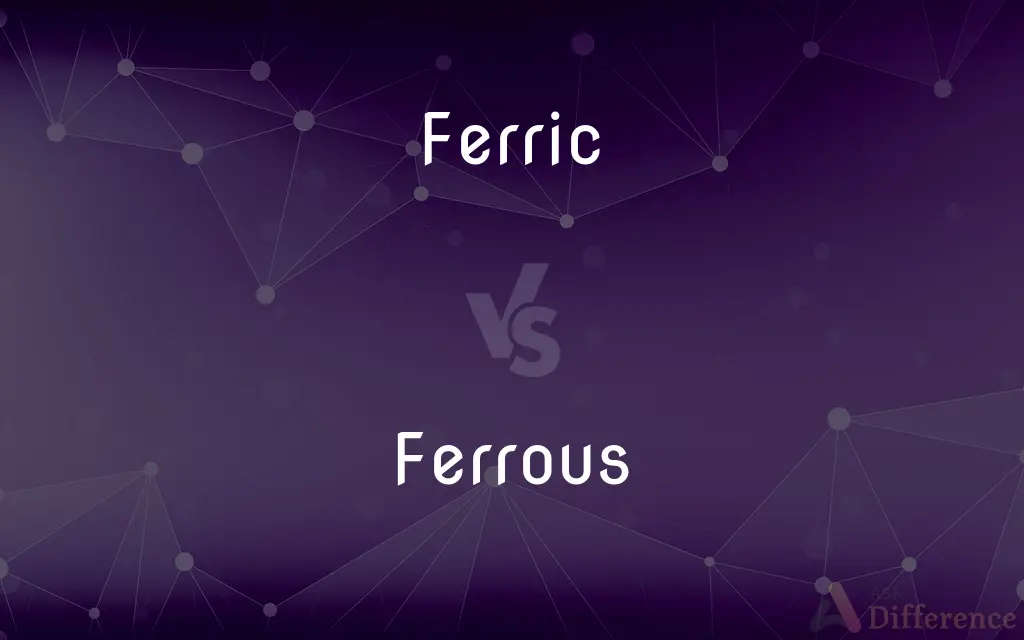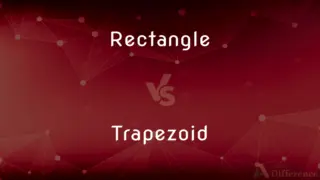Ferric vs. Ferrous — What's the Difference?
By Tayyaba Rehman & Fiza Rafique — Updated on March 14, 2024
Ferric refers to iron with a +3 oxidation state, often forming reddish compounds, whereas ferrous indicates iron in a +2 oxidation state, typically forming greenish or bluish compounds.

Difference Between Ferric and Ferrous
Table of Contents
ADVERTISEMENT
Key Differences
Ferric and ferrous compounds are two forms of iron differentiated primarily by their oxidation states: ferric (Fe^3+) and ferrous (Fe^2+). Ferric compounds, with iron in a +3 oxidation state, tend to form reddish-brown solutions or compounds, indicating their higher oxidation level. On the other hand, ferrous compounds, where iron is in a +2 oxidation state, usually appear greenish or bluish, reflecting their different electronic configuration.
In terms of chemical reactivity, ferric ions are less reactive compared to ferrous ions due to their higher oxidation state. Ferric ions have a stronger tendency to gain an electron to return to a more stable state, whereas ferrous ions, being in a lower oxidation state, are more reactive and more readily participate in oxidation-reduction reactions.
The solubility of ferric and ferrous compounds also differs in various environments. Ferrous compounds are generally more soluble in water than ferric compounds. This difference in solubility can significantly affect the bioavailability of iron in environmental and biological systems, impacting how organisms access and use iron.
In industrial applications, the distinction between ferric and ferrous compounds is crucial. Ferrous compounds are often used in the manufacturing of steel and other alloys due to their reactivity and strength. Ferric compounds, meanwhile, find their uses in water purification and as pigments due to their coagulating properties and color.
Environmental and health impacts of ferric and ferrous ions can vary. Ferrous ions are more readily absorbed by the human body, making them crucial for transporting oxygen in the body. Ferric ions, though also important, are less efficiently absorbed without being first reduced to the ferrous form within the digestive tract.
ADVERTISEMENT
Comparison Chart
Oxidation State
+3
+2
Color of Compounds
Reddish-brown
Greenish-blue
Chemical Reactivity
Less reactive than ferrous
More reactive
Solubility in Water
Generally less soluble
Generally more soluble
Industrial Use
Water purification, pigments
Steel manufacturing, alloys
Compare with Definitions
Ferric
Less reactive compared to ferrous compounds.
Ferric ions are more stable in oxidation-reduction reactions.
Ferrous
Indicates iron in the +2 oxidation state.
Ferrous sulfate is a common dietary supplement.
Ferric
Refers to iron in the +3 oxidation state.
Ferric chloride is used in water treatment processes.
Ferrous
Key in steel manufacturing and alloys.
Ferrous metals are essential for construction and automotive industries.
Ferric
Ferric compounds are less soluble in water.
Ferric hydroxide precipitates in neutral to basic solutions.
Ferrous
Compounds often appear greenish or bluish.
Ferrous sulfide gives off a greenish-black color.
Ferric
Compounds usually appear reddish-brown.
Ferric oxide forms rust on iron surfaces.
Ferrous
Ferrous compounds are more soluble in water.
Ferrous chloride is used in water treatment for its solubility.
Ferric
Used in water purification and as pigments.
Ferric salts are effective in coagulating contaminants.
Ferrous
More reactive and readily participates in redox reactions.
Ferrous iron is easily oxidized to ferric iron in the presence of oxygen.
Ferric
Relating to iron.
Ferrous
In chemistry, the adjective ferrous indicates a compound that contains iron(II), meaning iron in its +2 oxidation state, possibly as the divalent cation Fe2+. It is opposed to "ferric" or iron(III), meaning iron in its +3 oxidation state, such as the trivalent cation Fe3+.
Ferric
Relating to or containing iron, especially with valence 3 or a valence higher than in a corresponding ferrous compound.
Ferrous
(chiefly of metals) containing or consisting of iron.
Ferric
Pertaining to, derived from, or containing iron.
Ferrous
Of iron with a valency of two; of iron(II).
Ferric
(chemistry) Of compounds of iron in which it has a valence or oxidation number of 3
Ferrous
Relating to or containing iron, especially with valence 2 or a valence lower than in a corresponding ferric compound.
Ferric
Pertaining to, derived from, or containing iron. Specifically (Chem.), denoting those compounds in which iron has a higher valence than in the ferrous compounds; as, ferric oxide; ferric acid.
Ferrous
Of or containing iron.
Ferric
Of or relating to or containing iron
Ferrous
(chemistry) Of compounds of iron in which it has a valence or oxidation number of 2.
Ferrous
Pertaining to, or derived from, iron; - especially used of compounds of iron in which the iron has its lower valence of two; as, ferrous sulphate.
Ferrous
Of or relating to or containing iron
Common Curiosities
Can ferric ions become ferrous?
Yes, ferric ions can be reduced to ferrous ions in redox reactions.
How are ferrous compounds different from ferric?
Ferrous compounds have iron in a +2 oxidation state, making them more reactive than ferric compounds.
How does the solubility of ferric and ferrous compounds affect their applications?
Ferrous compounds' higher solubility makes them suitable for dietary supplements and steel manufacturing, while ferric compounds' lower solubility suits them for water treatment and pigments.
What defines ferric compounds?
Ferric compounds contain iron in a +3 oxidation state.
Why is ferrous iron more reactive than ferric iron?
Ferrous iron's lower oxidation state makes it more eager to participate in chemical reactions, including oxidation.
Are ferric and ferrous compounds safe?
Generally, they are safe in controlled applications, but excessive exposure can have environmental or health risks.
Why are ferrous compounds green or blue?
The green or blue color is due to the electronic configuration of the ferrous ion.
What are common uses of ferric compounds?
Ferric compounds are used in water purification and as pigments.
Can the body use ferric iron efficiently?
The body prefers ferrous iron for absorption; ferric iron must be reduced to ferrous iron in the digestive tract for efficient absorption.
What role does the oxidation state play in ferric and ferrous compounds?
The oxidation state affects their chemical reactivity, color, and applications.
How are ferric and ferrous compounds prepared industrially?
They are prepared through various chemical processes, including oxidation and reduction reactions.
How does the presence of ferric and ferrous ions affect water quality?
Their presence can indicate contamination levels and affect water treatment processes, influencing overall water quality.
Do ferric and ferrous ions occur naturally in the environment?
Yes, they naturally occur in various environmental settings, affecting soil chemistry and aquatic systems.
What happens to ferric and ferrous ions in water?
Ferrous ions can oxidize to ferric ions in water, especially if oxygen is present.
Share Your Discovery

Previous Comparison
Rectangle vs. Trapezoid
Next Comparison
Bharatanatyam vs. KuchipudiAuthor Spotlight
Written by
Tayyaba RehmanTayyaba Rehman is a distinguished writer, currently serving as a primary contributor to askdifference.com. As a researcher in semantics and etymology, Tayyaba's passion for the complexity of languages and their distinctions has found a perfect home on the platform. Tayyaba delves into the intricacies of language, distinguishing between commonly confused words and phrases, thereby providing clarity for readers worldwide.
Co-written by
Fiza RafiqueFiza Rafique is a skilled content writer at AskDifference.com, where she meticulously refines and enhances written pieces. Drawing from her vast editorial expertise, Fiza ensures clarity, accuracy, and precision in every article. Passionate about language, she continually seeks to elevate the quality of content for readers worldwide.
















































